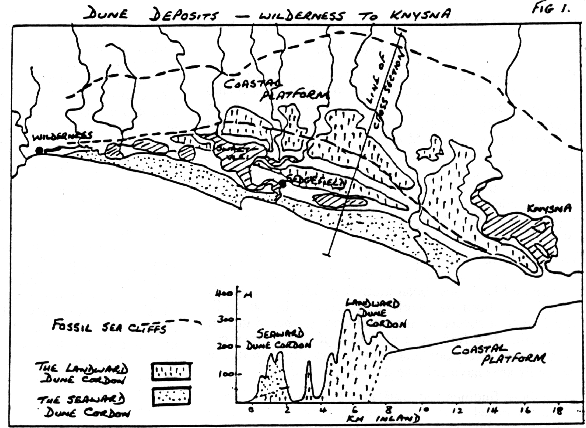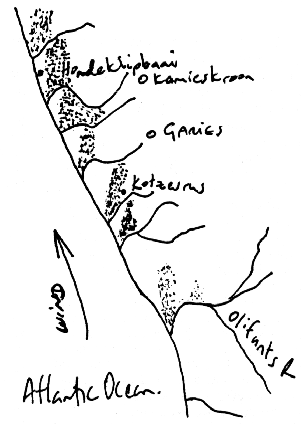
Home
Mission
Overview of Project
Project Staff
Sponsors
Achievements
Checking, Illustrations
Upcoming Activities
Id and Species Lists
Protea Information
Protea Gallery
Growing Proteas
Interim Dist. Maps
Publications
Afrikaanse Inligting
![]()
Proteas don't walk very fast
Some Observations from the Sedgefield Dunes
Dave Jones, Sedgefield
Protea Atlassers working around Sedgefield have some very varied and interesting terrain to cover. Just inland from the village and the coastal plain, is a well-defined upland plateaux which is an ancient marine platform between the Outeniqua Mountains and the coastal dunes. Signs of an old sea cliff can be see along the base of the mountain, and another one on the seaward side which is between 5 and 10 million years old. Further, on the seaward side of this second cliff, are remarkable series of active and fossil dunes, that owe their origin to changes in sea level during the ice ages.
Of interest to Atlassers, is the fact that these coastal dunes around Sedgefield have been the subject of many studies and have now been accurately dated. Especially notable has been the work done recently by Dr W.K. Illenberger, a specialist in coastal Geology based in Port Elizabeth. His findings and dating of these dunes can provide interesting pointers to the apparently slow rate at which Proteas have colonized these giant dunes.
From these findings and work now being done by Protea Atlassers based around Sedgefield, three distinct plant horizons can be identified. The Mature Coastal Platform, a Landward Cordon of Fossil Dunes, and a Seaward Cordon of Recently Active Dunes. (See Figure 1.)

The Mature Coastal Platform has been pretty well covered by the Atlassers and consists of patches of undisturbed Fynbos scattered among a patchwork of pine plantations, intensively farmed areas, and deep kloof with thick indigenous bush. Proteas abound on the uplands wherever the Fynbos has been left undisturbed, but the varieties are limited. Mainly King Sugarbush - Protea cynaroides, Narrow-leaf Sugarbush - Protea neriifolia, Wart-stemmed Pincushion - Leucospermum cuneiforme and the ubiquitous Common Sunshine Conebush - Leucadendron salignum. Pr cynaroides, in particular, does very well, but, strangely enough, seems to be the elliptic-leaf variant rather than the small-leaf variant, which one might expect. (But this coastal platform averages around 200m in altitude and may be too high.)
Since this platform has been above sea level for 10 million years or more, the Proteas found there have had plenty of time to "get their roots down" and seem very much at home. Within this zone interesting local variations in distribution occur, probably linked with the geology.
The Landward Cordon of Fossil Dunes has been dated at between 600-900 thousand years old, with those towards the sea being younger, but still dating into earlier interglacial phases of the Pleistocene and the Holocene and between 200 and 500 thousand years old. These dunes are now very stable and cemented into a soft form of dune rock. In the area immediately to the north of Groenvlei, they reach altitudes of over 300 m and overlie some of the older coastal platform, covering much of the seaward fossil cliff of the coastal platform in the process. These fossil dune lines can be easily traced, as they run just north and parallel to the National road from Goukamma towards Sedgefield, after which they turn inland and are bisected by Swartvlei Lake. West of the lake they continue as the prominent dunes of the Dune Rat Trail and come to an end at Rondevlei Village. An interesting and later fossil sea cliff can be traced all along the seaward face of this dune line, immediately to the north of the National Road.
Although much of these dunes have been planted with pines or have been invaded by alien vegetation, patches of the original fynbos have survived, where healthy, well-established Pr cynaroides, Ls cuneiforme and Ld salignum have all been plotted. However, since these dunes are all more than 200 000 years old, Proteas have also presumably had enough time to get established.
The Seaward Cordon of Recently Active Dunes is where the botanical interest really lies, and my curiosity was first aroused when a party of us went atlassing in the Goukamma Nature Reserve. We found no Proteas at all, but there was plenty of Fynbos on stable dunes and tucked between invasions of alien vegetation. Subsequent visits to the coastal dunes south east of Sedgefield, south of Sedgefield, and further west towards Wilderness have confirmed this absence to be general. These high dunes are all stable, well vegetated, and blessed with a rich variety of other Fynbos. (Once well known property on these dunes and destined soon to become yet another golf-course estate, is actually called "Fynboskruin".) But to date no Proteas have been plotted. However, they get pretty close in places and examples of Ld salignum can be found within metres of these dunes. Apparently still "looking" but not yet climbing or leaping!
The key to this lack of Proteas on the coastal dune line can be in Dr Illenberger's dating of these hills and a distinctive slope break visible on the north facing (inland) face of the dune line. The dune sand below this slope break is significantly older (100 - 130 000 years) than the deposits that lie above it, and are consolidated into soft dune rock which becomes exposed along the present shore line as a distinctive line of sea-cliffs. The overlying dune, reaching an altitude of 180 m in places, is much younger although still largely as old as 6 000 years. (In places these young dunes were still building as recently as 50 years ago, until dune stabilization, encroaching alien vegetation and housing halted the process.) It is on these stable, well-vegetated, although still comparatively young, dunes that proteas are conspicuously absent, and the boundary line can be quite distinctive. (See Figure 2.)

Two locations close to Sedgefield reveal clearly this horizon between the older, Protea-colonized dunes, and the younger deposits. Immediately east of the village the N2 crosses a low dune which appears to be an outlier of the older dune to the north, and proteas (notably Ld salignum) are visible at the side of the road, extending south towards the newer dunes. Although the area is being rapidly built up (suburb of Meadings Ride) remnants of the original Fynbos, with patches of Ld salignum are visible right up to the base of the dune, which here is very stable and has mature indigenous forest at its base. Some 10 km to the west of Sedgefield is an even more striking location where a developer, high in coastal dune cordon, has over the last decade embarked on a programme of alien vegetation clearance and where the indigenous vegetation has re-appeared (Twee Valleyen). Here, to the north of the N2 well-developed Fynbos is evident, with plenty of Ld salignum present, but south of the road there are no Proteas visible. It is almost as if the N2 road has created a boundary between the two plant horizons under discussion, but this is not so. Rather the road engineers have followed a natural line in their construction, which matches the slope break, previously identified, between the old dunes and the younger overlying material. (Fig. 2.)
This Seaward Dune Cordon, Protea Horizon is most fascinating, and it will have to be left to botanists to explain it, but a link with the age of slope break which forms this horizon seems likely. Simplistically, it can be suggested that these dunes are still unstable and that Proteas have not yet had time to colonize them. While this explanation might fit well those places where active dune building has been in progress in historic times, it does not explain why the older parts of these "active dunes" are so well covered with mature fynbos, especially ericas, and why 6 000 years is not long enough for proteas to have become established.
A possibility, as suggested by tongue-in-cheek title to this article, is that proteas advance only slowly from areas where they are well established onto new ground, and that 6 000 years is not long enough for this process to have happened in the Sedgefield dunes. The writer knows nothing about the relative abilities of Proteas and other Fynbos families to spread, nor anything about their respective seed dispersal capabilities, but observations from around the Conservation Research Station at Rondevlei suggests that proteas can move pretty quickly if conditions are right.
At some stage, but probably within the last 50 years, a selection of exotic proteas was planted around this research station, including Stink-leaf Sugarbush - Protea susannae and some are managing to spread and to colonize the surrounding Fynbos. Pr susannae, in particular, seems to like the local conditions and has already spread as far as 1 km from the station in places. Continuing at this rate, it will be able to reach the slope break and its plant horizon easily within 100 years. But will these plant pioneers also still be found sitting at the slope break, apparently waiting in the traffic before crossing the road, by an observer 6 000 years hence?
The amateur geologist and Protea Atlasser responsible for these observations and for this article waits with interest for comment from the botanists and, hopefully, a simple explanation to his problem.
Further reading and references:
Illenberger, W. K. The Geographical Evolution of the Wilderness Dune Cordons, S. Afr. Quat.
Int. 33: 11-20.
Lewis, C. A. (1996). The Geomorphology of the Eastern Cape. Grocott & Sherry
Publishers.
 Dunes
are an important phenomenon for proteas. The simple answer as to why proteas are not found
on the younger dunes is that they are too rich in Calcium. As the dunes mature, leaching
occurs, and their pH decreases. The moment they are acidic enough proteas will move onto
them. Protea seeds may move kilometres (for Conebushes and Sugarbushes anyway) per fire
event, especially if fires are followed by gale-force winds. Pincushions and allies
(relying on ants) move much more modest distances per fire event.
Dunes
are an important phenomenon for proteas. The simple answer as to why proteas are not found
on the younger dunes is that they are too rich in Calcium. As the dunes mature, leaching
occurs, and their pH decreases. The moment they are acidic enough proteas will move onto
them. Protea seeds may move kilometres (for Conebushes and Sugarbushes anyway) per fire
event, especially if fires are followed by gale-force winds. Pincushions and allies
(relying on ants) move much more modest distances per fire event.
Most dunes in South Africa start at rivers and move west (south coast) or north (west coast) along the coast. Further from the river mouths they tend to be older, to be more acidic, and to harbour proteas. Ironically, at the next river they tend to stop, washed away down to the sea to begin the process all over. Few dunes cross rivers – even rivers that flow only once every hundred years seem to stop the dunes. In the area north of the Olifants River, Leucospermum praemorsum, Common Sandveld Pincushion - Leucospermum rodolentum and Leucadendron brunioides all appear to thrive on the older portions of these dune systems. (Thanks Ivor Jardine for finding the proteas and Philip Desmet for explaining the pattern). Ls rodolentum appears to have crossed the mountains and spread eastwards from the west coast towards Robertson by piggybacking on dunes from the Breede River.
Tony Rebelo
Back PAN 48